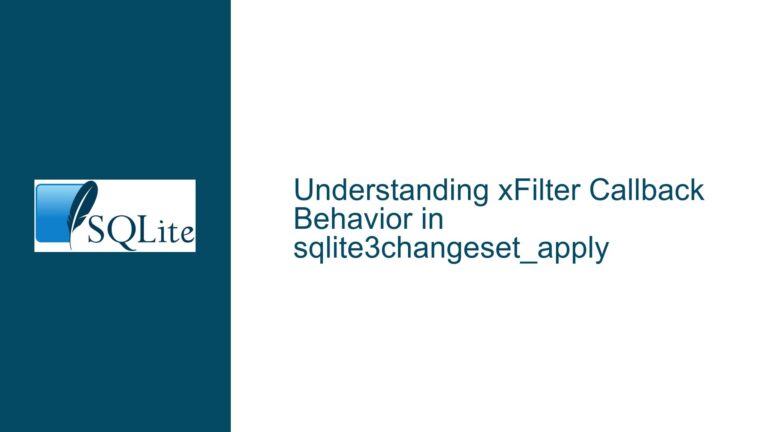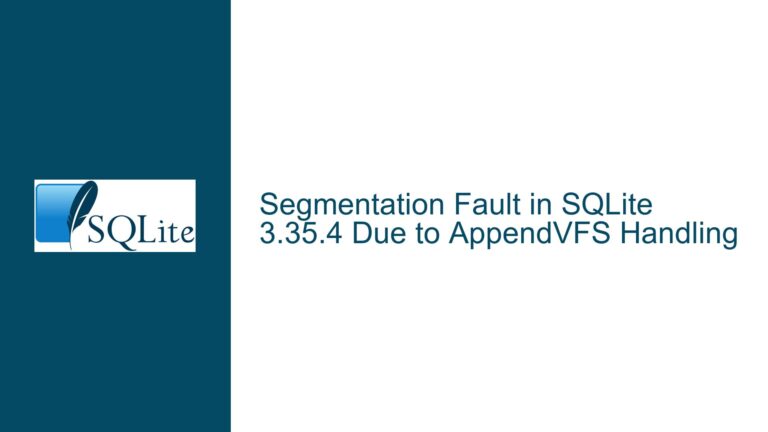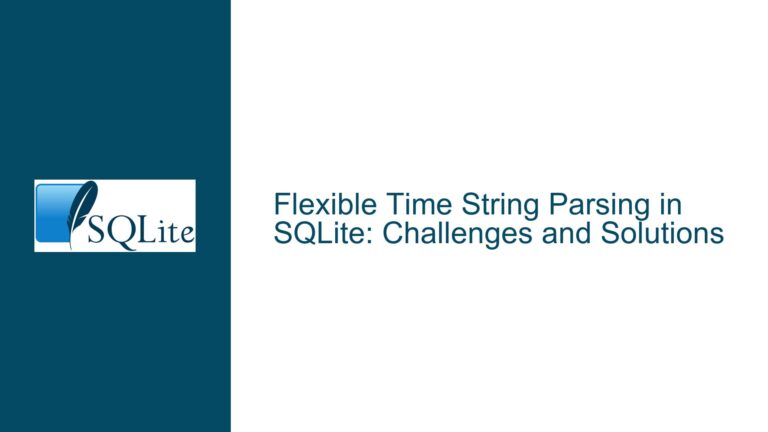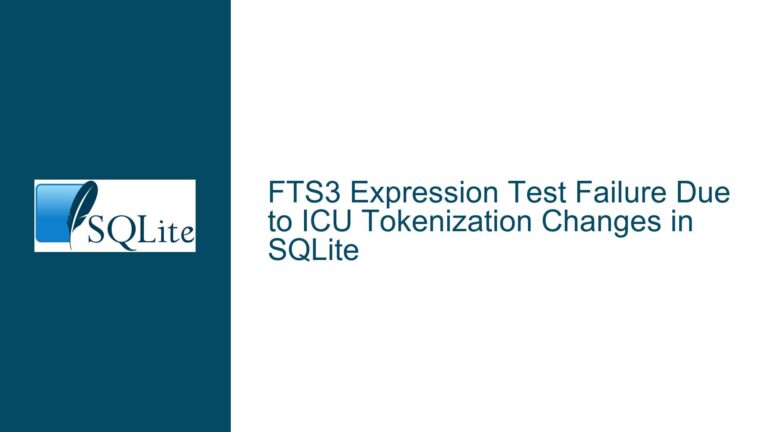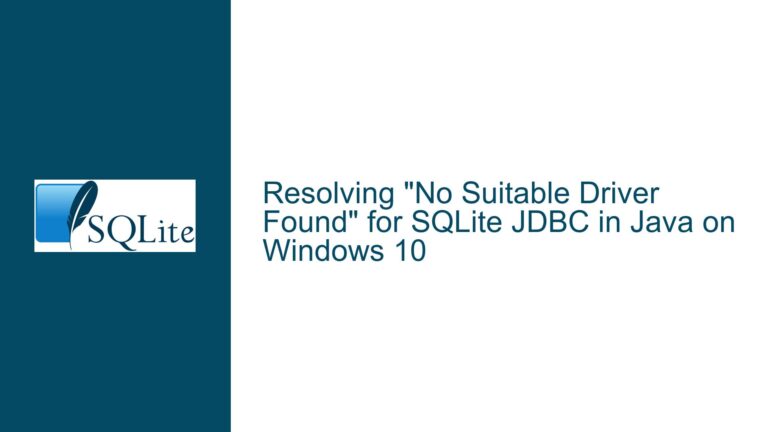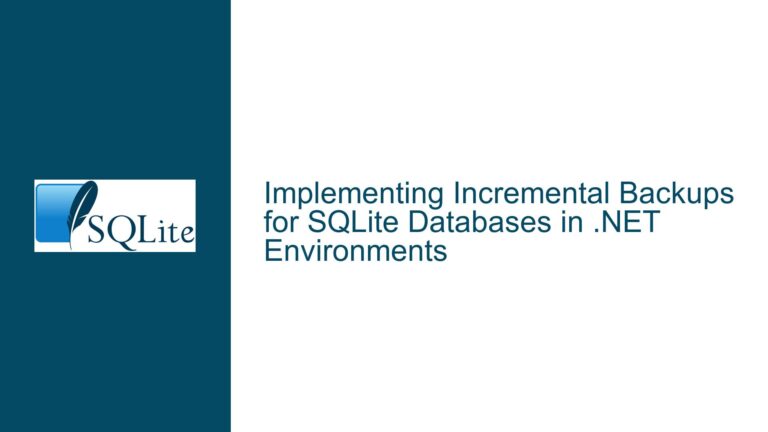Assessing Production Readiness and Merge Timeline for SQLite’s Begin-Concurrent-PNU-WAL2 Branch
Understanding the Begin-Concurrent-PNU-WAL2 Branch and Its Significance
The begin-concurrent-pnu-wal2 branch in SQLite introduces experimental support for concurrent write transactions through the BEGIN CONCURRENT command. This feature aims to address SQLite’s traditional limitation of allowing only one writer at a time, even when using Write-Ahead Logging (WAL) mode. The branch represents a multi-year effort to enable multiple processes or threads to write to the database simultaneously without blocking, thereby improving scalability for high-concurrency workloads.
At its core, the branch modifies SQLite’s locking mechanisms and WAL management to allow overlapping write transactions. Traditional SQLite WAL mode allows multiple readers and one writer (via exclusive locks), but BEGIN CONCURRENT relaxes this by using a Prohibit-Null-Upgrade (PNU) protocol. PNU ensures that transactions can proceed without requiring immediate exclusive locks, provided no transaction attempts to upgrade from a read to a write lock (a "null" upgrade). This reduces contention and enables parallel writes under specific conditions.
The branch has seen periodic updates since its inception, with recent activity suggesting ongoing refinement. However, its absence from the SQLite trunk (main development branch) raises questions about stability, performance trade-offs, and unresolved edge cases.
Factors Delaying Production Readiness and Trunk Integration
1. Concurrency Model Complexity and Edge Cases
The BEGIN CONCURRENT implementation introduces a novel locking strategy that must handle scenarios such as transaction rollbacks, deadlock detection, and recovery from crashes or power failures. SQLite’s ACID compliance demands rigorous handling of these edge cases, which may not yet be fully addressed. For example, if two concurrent transactions modify overlapping rows, SQLite must resolve conflicts without violating isolation guarantees. Testing such scenarios requires extensive stress-testing frameworks, which may still be under development.
2. Performance Overheads in High-Contention Workloads
While concurrent writes reduce contention in low-conflict scenarios, they may introduce overhead in high-contention environments. The PNU protocol requires additional bookkeeping to track transaction intentions, which could degrade performance if transactions frequently abort due to conflicts. Additionally, the WAL2 component (an evolution of the WAL file format) may not yet optimize for scenarios where multiple writers are appending to the WAL simultaneously, leading to increased I/O latency.
3. Integration with Existing SQLite Features
SQLite’s ecosystem includes features like virtual tables, full-text search (FTS), and extensions (e.g., JSON1). The begin-concurrent-pnu-wal2 branch must ensure compatibility with these components. For instance, virtual tables that rely on global state or external resources might not behave correctly under concurrent writes. Similarly, FTS’s shadow tables could experience race conditions if concurrent transactions update the same document. Resolving these integration issues requires meticulous testing.
4. Stability and Long-Term Support Considerations
SQLite’s reputation for reliability stems from its exhaustive test suite and conservative development approach. Merging a feature as impactful as BEGIN CONCURRENT requires validation across diverse platforms (e.g., embedded systems, mobile devices) and filesystems (e.g., FAT32, NTFS, ext4). The SQLite team may be awaiting real-world feedback from early adopters before committing to long-term support.
5. Documentation and Community Adoption Barriers
The branch’s experimental status means official documentation is sparse. Developers attempting to use BEGIN CONCURRENT must rely on source code analysis or community discussions, increasing the risk of misuse. Without clear guidelines on transaction retry logic, conflict resolution, or WAL2 configuration, production deployments carry inherent risks.
Evaluating Stability, Mitigating Risks, and Planning for Adoption
Step 1: Analyze Test Coverage and Known Limitations
Review the SQLite team’s public test results for the branch. The SQLite source repository includes test cases (e.g., test/concurrent.test) that stress the BEGIN CONCURRENT implementation. Run these tests in your target environment to identify platform-specific issues. Pay attention to tests involving:
- Rollback journal interactions: Ensure crash recovery works when concurrent transactions are active.
- Lock escalation failures: Verify that transactions waiting for locks timeout or retry correctly.
- Foreign key constraints: Concurrent writes to related tables must respect constraint checks.
Step 2: Benchmark Performance Under Realistic Workloads
Design benchmarks that mirror your application’s read/write patterns. Use tools like sqlite3_analyzer or custom scripts to measure:
- Write throughput: Compare transactions per second (TPS) between traditional WAL mode and
BEGIN CONCURRENT. - Latency spikes: Monitor for stalls caused by transaction retries or lock contention.
- WAL file growth: Concurrent writes may enlarge the WAL file faster than it can be checkpointed, risking storage exhaustion.
Step 3: Implement Contingency Plans for Transaction Conflicts
Prepare for scenarios where concurrent writes conflict:
- Exponential backoff: Retry failed transactions with increasing delays to reduce contention.
- Application-level locking: Use advisory locks (e.g., a dedicated
locktable) for critical sections that cannot tolerate retries. - Conflict resolution hooks: SQLite’s
sqlite3_preupdate_hookcan help detect and resolve row-level conflicts before they trigger aborts.
Step 4: Monitor and Contribute to Community Discussions
Engage with the SQLite mailing list and GitHub repository to track progress on the branch. Key indicators of imminent trunk integration include:
- Merging of dependent subsystems: If WAL2 or PNU components are merged separately, it signals incremental stabilization.
- Documentation drafts: Pre-release documentation updates often precede official releases.
- User testimonials: Feedback from large-scale deployments (e.g., mobile apps, IoT platforms) can validate production readiness.
Step 5: Prepare for Migration and Fallback Strategies
If adopting the branch in production, plan for eventual upgrades to trunk versions. Use runtime checks to enable BEGIN CONCURRENT only when available:
-- Check for BEGIN CONCURRENT support
SELECT sqlite_compileoption_used('SQLITE_ENABLE_BEGIN_CONCURRENT');
Maintain compatibility with standard SQLite builds by encapsulating concurrent transactions behind conditional logic. For example, use a wrapper function that falls back to BEGIN IMMEDIATE if BEGIN CONCURRENT is unavailable.
Step 6: Collaborate with the SQLite Team
Contribute test cases or bug reports if you encounter issues. The SQLite team prioritizes real-world feedback, especially for features targeting high-concurrency use cases. Submitting reproducible test cases accelerates fixes and demonstrates demand for the feature.
By systematically addressing concurrency edge cases, validating performance, and engaging with the SQLite community, developers can mitigate risks while leveraging the begin-concurrent-pnu-wal2 branch’s capabilities. Until the feature graduates to the trunk, treat it as a high-reward but high-maintenance component requiring vigilant monitoring.

